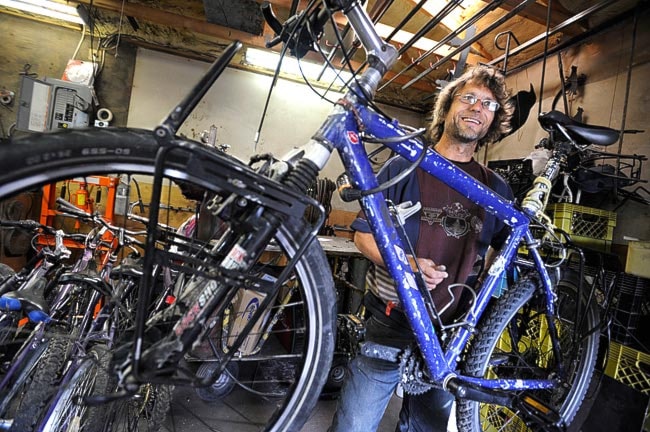Philippe LeBlond was too shy to chase girls when he was 14, so he “grabbed wrenches and started tinkering with bikes.”
He hasn’t stopped. While studying physics at the University of British Columbia, he ran a mobile bike-repair business. After two years there, he earned a diploma in mechanical design at a technical school.
He came up to Whitehorse in the early ‘90s, where he worked at a local shop, then travelled the territory with a mobile-bike service for seven years before settling in Whitehorse.
In the late ‘90s, his “tinkering” led to him to begin the Purple Bike Project. LeBlond takes old bikes, often donated from others, and repairs them.
He began painting the bikes purple because it was his then-girlfriend’s favourite colour. He rents the “Frankenbikes” out “from breakup to freezeup,” usually from April to October.
North of Ordinary magazine recently listed the initiative as one of the Top 10 things in Whitehorse. As well, tourists stop almost every day to admire the geodesic dome made of bike rims in front of his house.
“I see so many bikes going into the dump being thrown out,” the kinetic artist said from his Riverdale garage as he worked on a visitor’s bicycle. “We’re such a rich society. It’s sad to see all these bikes being thrown into the garbage, and all they need is a little bit of work, or a fair amount of work.”
The project has worked successfully because of LeBlond’s efforts. But this season, it almost didn’t last.
Most years, LeBlond has run the project entirely by himself.
For the past two years, it operated out of Cadence Cycle, the bicycle shop he previously owned. This year, he partnered with Raven Recycling, but unspecified “systematic problems” caused him to suspend the project in June.
But like the bikes, it has been salvaged. People will now go to Bringing Youth Towards Equality’s office on Ogilvie Street to rent the bikes, while the Boys and Girls Club on Sixth Avenue will provide storage. Profits will be split between LeBlond and the two organizations.
It fits well with what BYTE already does, said executive director Chris Rider. The project involves “taking things that would otherwise be trash ... and turning them into something brand new,” he said.
Apart from Rider, all of BYTE’s employees are under 25. “We all love bikes,” he said.
BYTE employees already work to make their office “green,” and the purple project is that - in more ways than one.
The environmental part is important, but the purple bikes program also helps the self-employed LeBlond pay his bills.
“When it works well, it turns a small profit,” he said, estimating he can make $75 or $100 per bike.
Riders pay a $150 deposit for the season. It costs $10 to rent a bike for the first day. The next two days cost five dollars each, and the next four are three dollars each. After the first week, it costs a dollar a day, up to half of the deposit.
LeBlond will repair damages. Riders must provide their own locks and helmets.
People from across the country have used his bikes - some say they work better than the ones they own Outside. It’s like buying shoes, he said. He needs to keep various styles on hand to give people selection.
Most of the bikes are old mountain bikes, and he professes a particular fondness for old cruisers. This year, “kids from Ontario” have wanted bikes with skinny tires, he said.
It’s not just tourists and transients pedaling purple bikes. Government departments use them as well.
The bikes generate money year after year. Around 80 per cent are returned to him, he said. The oldest ones are about 10 years old. Over a decade, one bike could bring in a $1,000 in small increments.
But with the time he spends working on the bikes, LeBlond knows he doesn’t earn much on an hourly rate. He’s adamant it be called a project not a program - programs receive government subsidies. This does not. It’s entirely self-funded.
“It’s not a socialist project,” he said. “It’s a social project.” But he may apply for funding in the future, he said.
Despite this year’s bumps, LeBlond has no plans to slow the project down. If the past is any indication, the project can only grow.
He began with about 20 bikes. Now, his fleet includes around 90 bikes. He hopes to have over 100.
LeBlond names and numbers each bike. They each have a story, and are all his favourites, like children, he said.
He began naming them after gods from various pantheons - he is especially fond of a bike named Emkidu. But after naming 50 or 60 bikes for gods, he got bored. So he switched to cheeses.
He may start naming some after elements on the periodic table, he said. The number of elements alone should make sure the project continues for a while yet.
Contact Meagan Gillmore at
mgillmore@yukon-news.com
